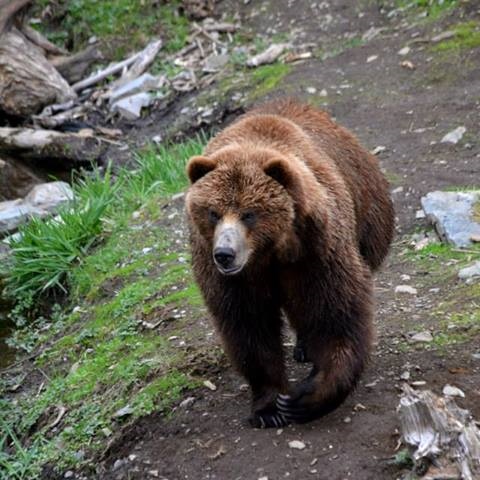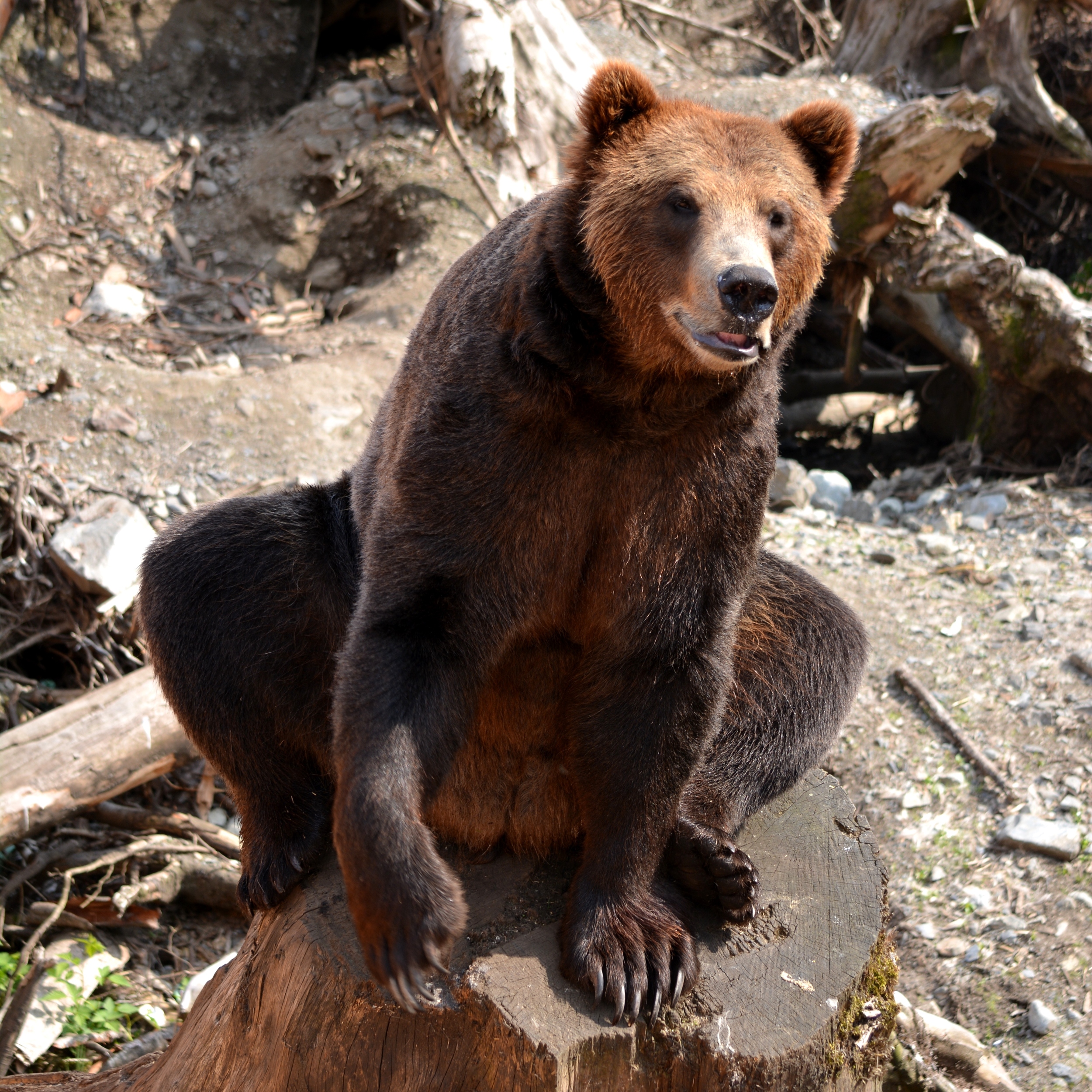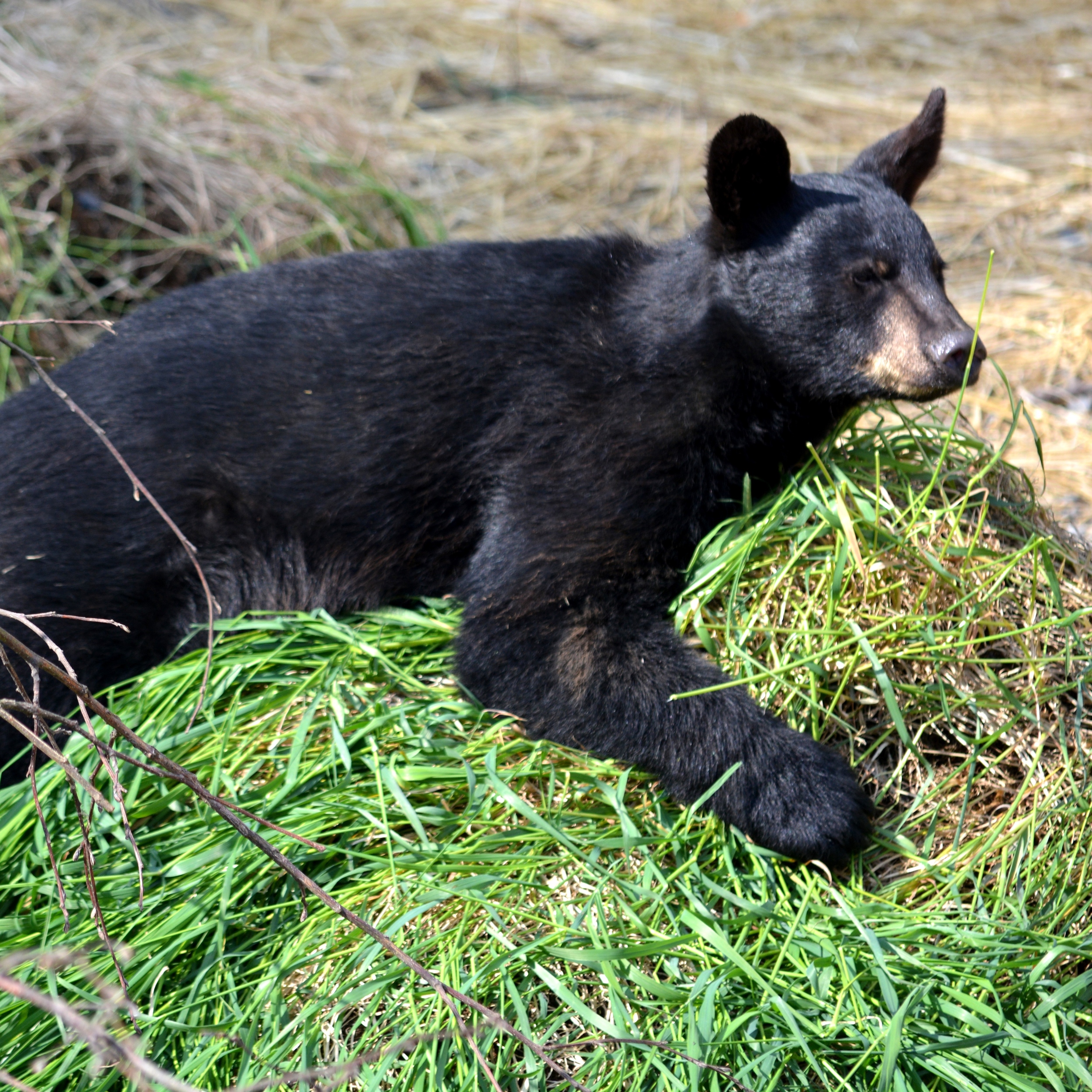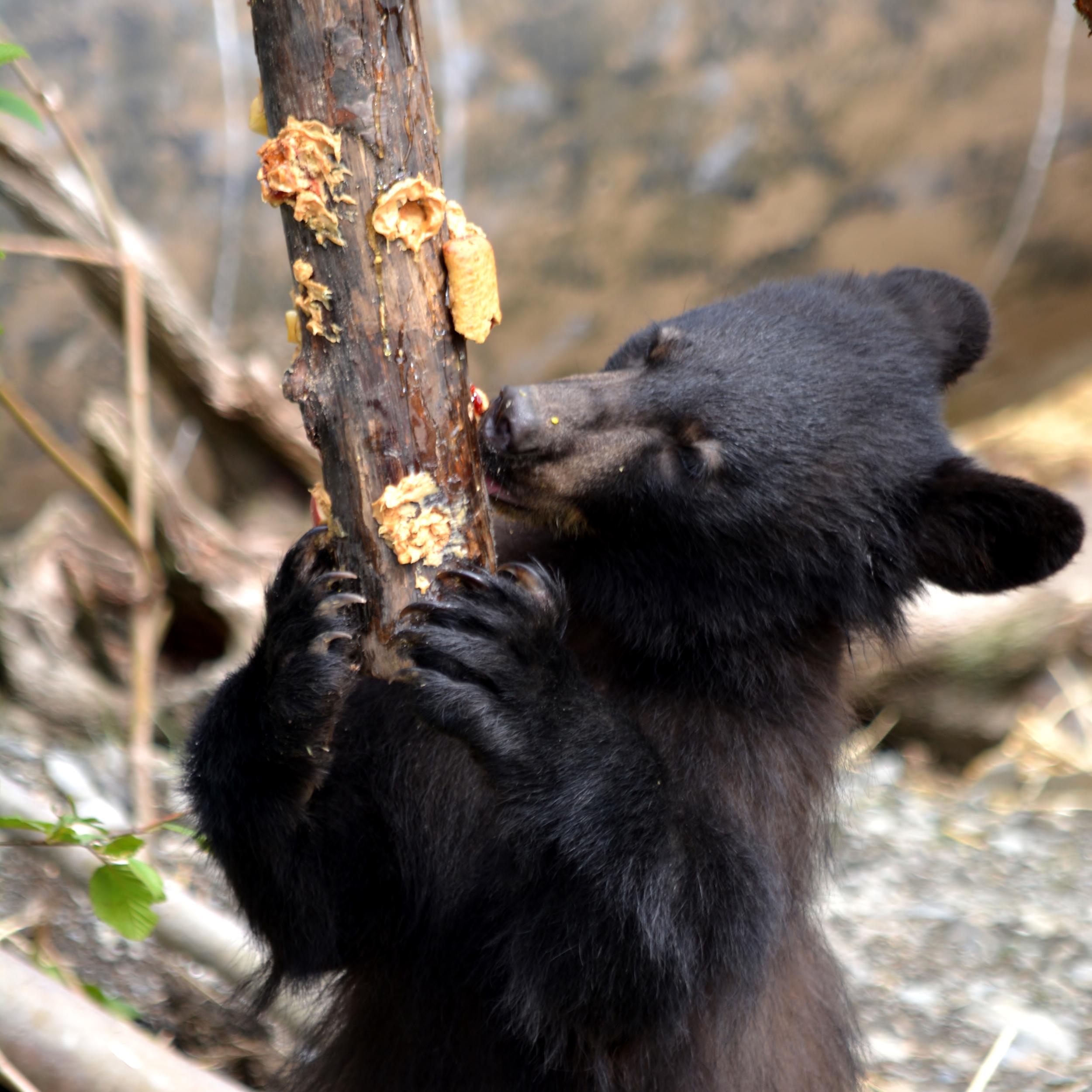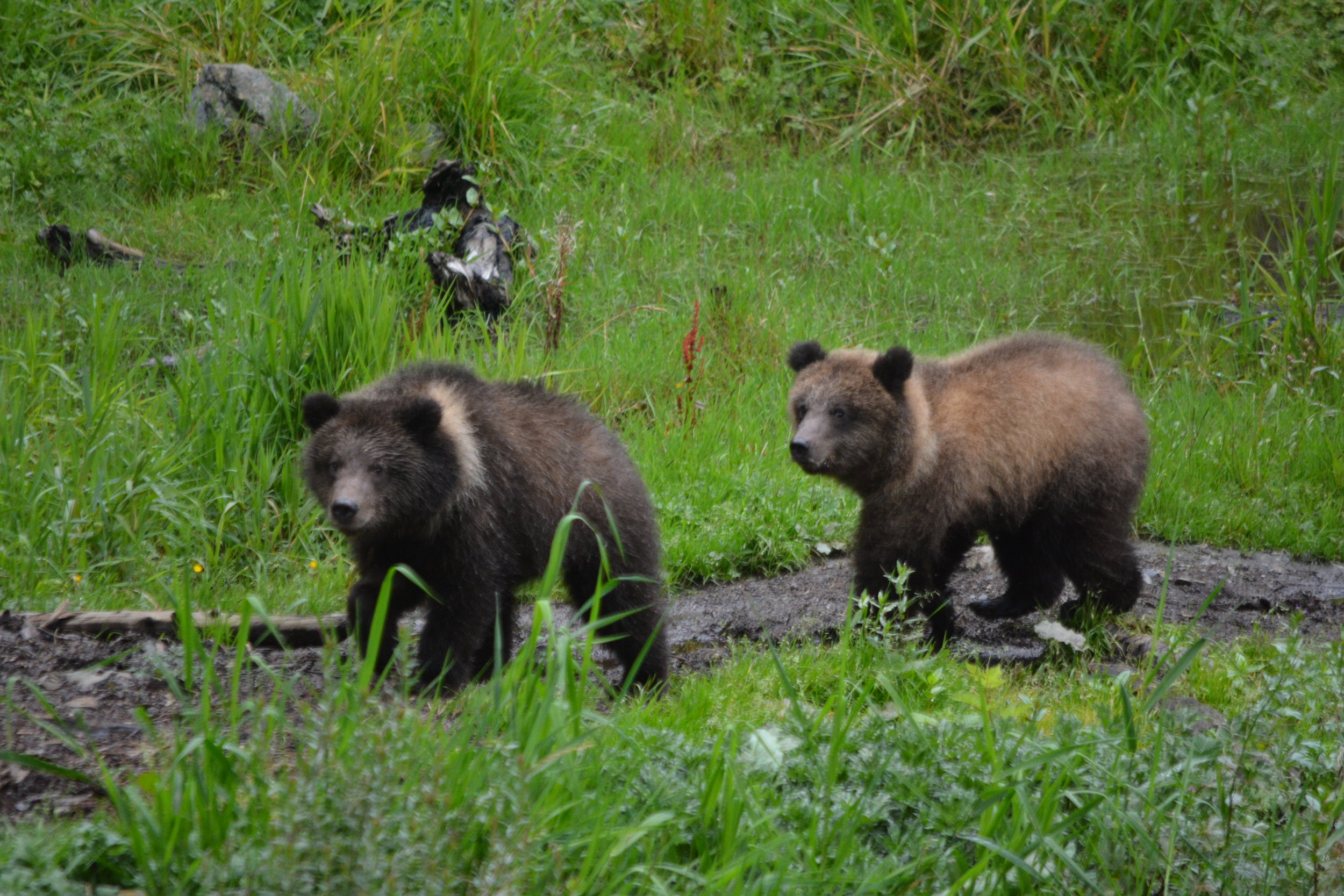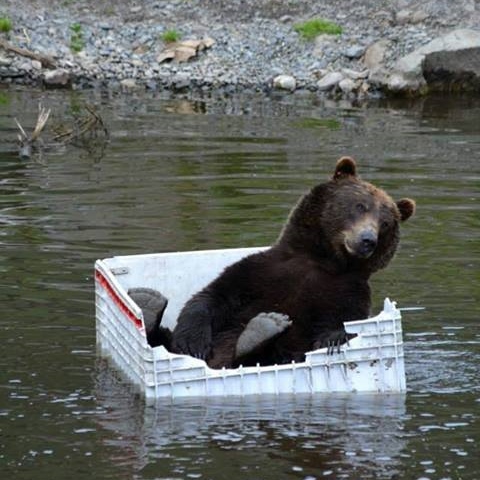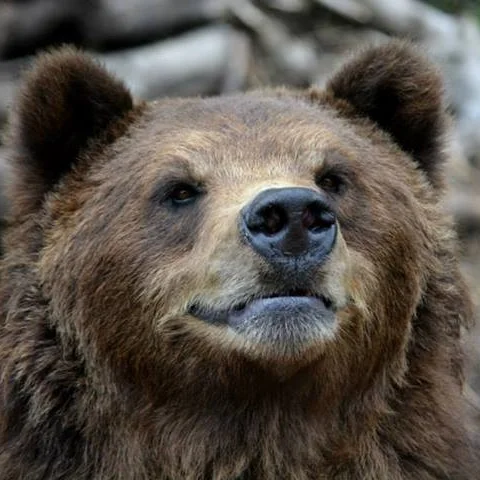The Bears
Toby
Toby is our lone female brown bear, also known as a sow. Toby and her brothers found us when they were 1½ years old after their mother died from ingesting plastic bags found in a garbage can.
Although Toby will never have children of her own, since there is no captive breeding allowed in Alaska, she has taken on the role of mother when it comes to her brothers, Balloo and Lucky. When her brothers had surgery to remove the possibility of breeding, she stayed by their side until they were back to a good state of health.
Of all of our 5 bears, Toby likes to eat. All of the bears enjoy their food, but Toby just loves to eat! She is the first one to the gate, when food is being prepared. Even her larger brother Balloo can’t win when there is food to be eaten.
Toby was our first bear to pick up the concept of signing for more food, by putting her paws together in front of her chest. From a very early age she always played with her hands, so the trainers capitalized on her movements until they had successfully trained Toby to make the 'more' sign. With her large appetite, Toby is quite persistent in signing for 'more' to her keepers!
Toby’s enjoyment of play, her nurturing of the other bears and feisty ways make her a favorite among guests to Fortress Of The Bear.
Lucky
Lucky found his way to Fortress Of The Bear along with his two siblings (Balloo and Toby) in August of 2010.
When these cubs first wandered into our then-empty bear habitat with their mother, the Alaska Department of Fish and Game decided to tag the bears so they could track them for research. A GPS collar was fitted on the mother and the cubs were given ear tags with a unique identification number on. These numbers were also painted on the side of each of the three cubs using peroxide, which bleached their fur. Lucky’s unique ID number was 13, hence the name Lucky!
We noticed that Lucky had an injured rear paw and a severe limp. We’re not sure what caused this; perhaps he had a fight with a big bear, or he may have been hit by a car. Regardless of the cause of his injuries, we don’t feel he would have survived on his own considering his inability to keep up with his siblings.
When Lucky first arrived at the Fortress to stay after his mother had been found dead from eating too much plastic trash, he didn’t interact much. He kept back, knowing he would be the last to get food or get the toy he wanted.
Now that has all changed! After some physiotherapy training with his keepers, such as getting him to stretch up tall, he is strong with no visible signs of his injured back paw. He has won the hearts of all the keepers, especially with his pouty bottom lip!
When the time comes to hibernate each year, Lucky nestles down in a culvert tube den inside the habitat. He drags straw and leafy material to make his den as comfy as possible – we have even seen him use a warm, fluffy deer hide as bedding! We are lucky to have him at Fortress Of The Bear.
Chaik
Chaik came to Fortress Of The Bear in July of 2007. He was with his mother, brother (Killisnoo), and sister on a small island with a fishing lodge outside of a small village called Angoon on Admiralty Island.
Hungry, his mother went into the kitchen of the fishing lodge around 2 o’clock in the morning and surprised the chef, who was forced to defend himself. She was shot and the three orphaned cubs scattered in the nearby forest.
The staff at the lodge began putting out food so that they could capture the cubs. If they didn’t the cubs would quickly starve. The first to appear and be captured was Killisnoo. Two months later, the Alaska Department of Fish and Game, finally caught Chaik. We had almost given up the hope of bringing his brother in. Chaik weighed 110 pounds when he arrived. He had been fed by the staff at the fishing lodge and was in fairly good health. The brothers were happy to see each other and so began their life in captivity.
Chaik currently holds the record here at the Fortress for largest bear. The calm, quiet beauty of Chaik makes him a regular favorite of our guests and staff.
Smokey
Smokey was the first of our three resident black bears to arrive, and she came to us through some amazing circumstances. Smokey is from Seward, and was originally one of three siblings, who were all orphaned in early October 2013 when their mother was shot and killed. Starving and scared, Smokey found herself in a small shack, that served as a cigarette break room for the staff of the Spring Creek Correctional Center. With nothing to eat besides candy wrappers and cigarette butts, the authorities were called, and Smokey ended up featuring in an episode of Alaska State Troopers! She was trapped and sent to an animal shelter.
With no rehabilitation program in Alaska, orphaned cubs in Smokey's situation are typically euthanized, as they cannot survive without their mother and there are very limited homes available in zoos. But Smokey got lucky when her story ended up on the news, in local papers and even on Facebook, where it was picked up by the Angels for Animals Network. Smokey's story went viral as thousands of people world-wide spread the word, and campaigned for her to be re-homed rather than destroyed. When we were contacted to take her at Fortress of the Bear, we quickly agreed! Although the state tried to find her and rescue her siblings also, they were initially unsuccessful, and sent us Bandit from Juneau instead. Six weeks later, Smokey's biological sister (Tuliaan) was found and sent to us.
Smokey arrived at our facility on October 24th 2013, to begin her new life in captivity. Since her arrival, she has been a pleasure to work with. She reminds her keepers of Toby - she's a fiery little cub that behaves quite motherly towards her siblings. She's quick to dive protectively on to a clump of grass or some other item that she's claimed, and one of her favorite pass-times is doing headstands and forward rolls in fresh, clean straw!
Bandit
Bandit, a male from Juneau, was sent to us at Fortress of the Bear as a replacement sibling for Smokey, when both her original biological siblings could not be located after they were orphaned. He arrived 4 days after Smokey, on October 28th 2013. Unlike Smokey, who had received rather a lot of human contact and attention when she was first trapped, Bandit was tranquilized while hiding in a crab apple tree and sent on the next plane to Sitka. He was very confused, wild and grouchy when he first arrived at our facility!
Our bear keepers spent long hours working closely with Bandit to build his confidence around people so that he would feel safe and secure in our care. After a few weeks of living up to his name and stealing any food bowls or other items he could get his paws on, he soon began to calm down, and learnt to take food from people's hands. When he began to warm up to and bond with one of our female keepers, we soon found that the best way to Bandit's heart was through his stomach! Whether it was a warm, gooey bowl of oatmeal or a pan of apple slices, Bandit was always the first to run to his keepers when food was involved!
Bandit is the largest of our three black bear cubs. As if he wasn't cute enough already, his most distinguishing feature is the white heart-shaped patch of fur on his chest.
Tuliaan
Tuliaan (or Tuli, for short) is our little Christmas miracle.
Tuli is Smokey's biological sister from Seward, so she was also orphaned in October 2013. But she was sadly presumed dead when she could not be found. Amazingly, she was located 6 weeks later, in the very same cigarette break room that Smokey had initially been found in. Tuli was in a terrible state when she was found. She was incredibly malnourished, her coat was in terrible condition and her face was full of porcupine quills. On her way to us, she stopped at the Alaska Zoo, where an incredible team of vets anesthetized her to carefully remove a total of eleven quills from her nose, mouth and throat.
It was December 17th 2013 when Tuliaan arrived in Sitka at 5am one snowy morning. She weighed a mere 17lbs. She was so small, we weren't sure if she was going to make it. But tiny Tuli was very quick to warm to her new family. She ate gently from our keepers hands within hours of arriving and was quick to tell Bandit to go away when he got too close! We could tell she was a survivor, and a real tough cookie.
Seeing as she arrived in mid-December, we toyed around with the idea of a festive, Christmassy name for this special little cub, but nothing seemed to suite her. So we consulted a native Tlingit dictionary, and found the name Tuliaan, which means 'gentle'. It couldn't have been a more perfect fit for such a sweet little cub.
Tuli is in much better shape now, with a glossy coat and a layer of fat around her belly, but she's still the smallest of our three cubs, and is likely to remain so. Although she still lives up to her gentle namesake with her keepers, she has become Tornado Tuli when it comes to her siblings! Despite being the smallest, one of her favorite things to do is race around the enclosure, pouncing on Smokey and Bandit to start wrestling matches!
Nuka
Nuka (left) & Nikiski (right)
Nikiski
Nuka & Nikiski
(The Seward Sisters)
Nuka and Nikiski, AKA ‘The Seward Sisters’, joined Fortress of the Bear on August 25th 2018, when they were 8 months old. Originally from Seward, the sisters were orphaned when their mother was shot and killed for breaking in to someone’s chicken coop, trying to provide food for her cubs.
After 3 weeks alone in the wild, struggling to find food to survive, the Alaska Department of Fish & Game allowed us the necessary permits to provide these sisters with a forever home. They were tranquilized and sent to the Alaska Zoo in Anchorage for health checks and spay surgeries. A week later, they flew to Sitka, escorted by Dr. Michelle Oakley and her Yukon Vet TV team!
Both cubs were understandably distressed upon arrival after a scary airplane ride, and they were certainly vocal about it! But by the end of their first day, both were accepting apple slices and other from their new keepers. So far, Nuka has proven to be the bolder of the two cubs, quicker to check out new toys and make trouble! Nikiski is more cautious, but grows in confidence every day!
The Bears That Have Left Us
Balloo
(January 2009 - October 2017)
Balloo was the largest of his sibling group, but when we first met him with his mother, he was a momma’s boy! Wherever she was, he was right by her side, putting his head on her while she slept and walking very close to her. He does bully his siblings because of his size, but he also backs down very quickly when challenged.
We know he is incredibly intelligent. One current Bear Manager presented Balloo with a common problem-solving test of intelligence, and was not surprised to find that he scored higher than cats, dogs and wolves.
Balloo came to us in July of 2010, and right away we knew we had a very special bear on our hands at Fortress Of The Bear. He is quick to learn, and loves attention from his new ‘momma’s’ – his keepers!
Balloo quickly covered the entire perimeter of his habitat and understood the lay of his land and it’s limitations. As keepers it is always difficult to know that these bears will never be released and know the spaciousness of the terrain around them.
We do take solace in knowing that we are committed to providing enrichment and nourishment that will keep them healthy and engaged as long as they are in our care.
In 2017, Balloo developed a spinal issue that caused irremediable mobility issues and began to affect his quality of life. Our team made it their mission to do everything possible for Balloo, including working with Dr Michelle Oakley and a team of specialists to determine the issue. When all options were exhausted, staff that have worked with Balloo since his rescue as an orphan made the difficult decision to euthanize him, ending his suffering. The pain of this loss runs deep, and we all miss him daily.
Killisnoo
(January 2007 - May 2020)
Killisnoo came to Fortress Of The Bear in July of 2007. He was with his mother, brother (Chaik), and sister on a small island with a fishing lodge outside of a small village called Angoon on Admiralty Island.
Hungry, his mother went into the kitchen of the fishing lodge around 2 o’clock in the morning and surprised the chef, who was forced to defend himself. She was shot and the three orphaned cubs scattered in the nearby forest. Killisnoo was the runt of the litter and the hungriest.
The staff at the lodge began putting out food so that they could capture the cubs. If they didn’t the cubs would quickly starve. The first to appear and be captured was Killisnoo. Our local biologist here in Sitka, Phil Mooney went to retrieve a very angry little cub and brought him to Fortress Of The Bear. This was our very first cub and we were very excited to have him. He was quite dirty and hungry and still very angry and tried to escape by going over every inch of his new holding area. It took about 3 days to get him to eat out of our hand and after 2 weeks we released him to his permanent habitat.
When Killisnoo woke from hibernation in spring 2020, staff noticed he was having some mobility issues. Despite our best efforts, his mobility issues were not treatable. Our team made the difficult decision to humanely euthanize Killisnoo in May 2020. Killisnoo's curiosity and playful nature made him a favorite of our guests and staff alike, and we miss him every day.

